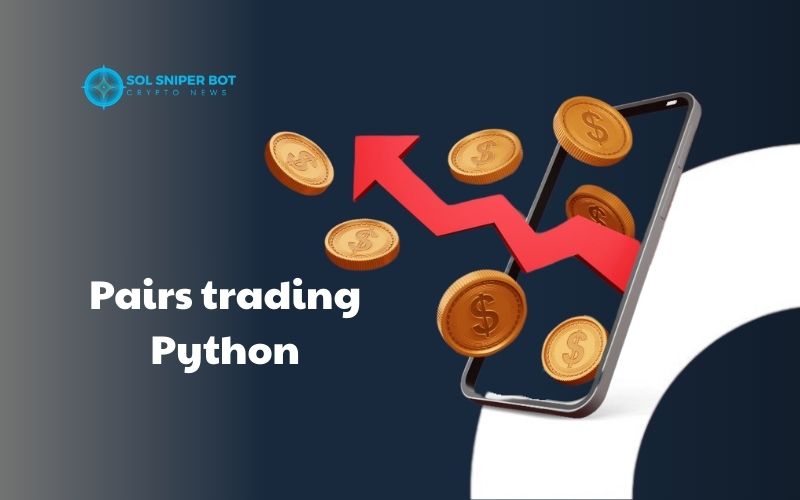Pairs trading Python is a smart strategy that leverages price discrepancies between two correlated assets to generate low risk profits. Thanks to its automation capabilities, Python helps traders quickly identify opportunities and streamline the entire investment process. This article will guide you through how to apply pairs trading using Python in detail, while also sharing practical tips to help you maximize your returns.
Contents
Why use pairs trading Python?

Pairs trading Python refers to using the Python programming language to execute the pairs trading strategy. This strategy identifies two assets with historically correlated prices, such as stocks from companies in the same industry. When their price spread widens, you buy the undervalued asset and sell the overvalued one, expecting their prices to converge. Python, with its rich ecosystem of libraries like Pandas, NumPy, and Statsmodels, is an ideal tool for building and testing this strategy.
Python automates data collection, statistical analysis, and trade execution, saving time and reducing errors. Its popularity in finance stems from its ability to handle large datasets and perform complex computations. Whether you’re a beginner or a seasoned trader, mastering pairs trading gives you a competitive edge in today’s financial markets.
Key benefits of pairs trading Python
Pairs trading Python offers significant advantages in automating pair trading strategies. Instead of manually analyzing and constantly monitoring the market, you can use Python to write scripts that automatically identify highly correlated asset pairs. This saves time, increases accuracy, and removes emotional bias from investment decisions. With the ability to pull real-time data from financial APIs, your analysis remains current and responsive. It’s an ideal tool for those looking to trade more efficiently in today’s competitive environment.
One of the biggest advantages of using Python is its flexibility in strategy backtesting. Libraries such as backtrader, zipline, or statsmodels allow you to simulate historical data, enabling you to assess the effectiveness of your strategy before risking real capital. This backtesting not only reduces risk but also helps optimize performance metrics such as the Sharpe ratio or drawdown. Python allows deep customization of your model, from timeframes to price deviation thresholds for trade entries.
Finally, Python enables seamless integration with trading platforms and large scale data analysis systems. You can easily connect trading bots to exchanges like Binance, Interactive Brokers, or Alpaca via API. Additionally, with tools like Jupyter Notebook, you can visualize data, analyze pair trading charts, and track strategy performance in an interactive format. Python not only enhances your trading intelligence but also helps build a flexible, automated investment ecosystem. This is why more and more traders are turning to pairs trading Python to improve their investment efficiency.
Steps to build a pairs trading system using Python
To implement pairs trading Python, you need a structured process that combines financial knowledge and programming skills. Below is a step by step guide to help you create an efficient and automated pairs trading system using Python.

Step 1: Collect data for pairs trading python
The first step is to collect historical price data for the two assets you want to trade. The data must be accurate and comprehensive to avoid errors in analysis. You can use libraries like yfinance or pandas-datareader to pull data from Yahoo Finance or other APIs. Processing the data with Pandas makes analysis and visualization much easier.
Step 2: Identify correlated pairs
Once the data is available, the next step is to identify asset pairs with a strong statistical relationship. Use Pandas’ .corr() function to calculate the correlation coefficient. A coefficient of 0.8 or higher is generally considered strong enough for a pairs trading strategy. Additionally, you should perform a cointegration test using the coint function from the statsmodels library to ensure the price spread is mean reverting.
Step 3: Calculate spread for pairs trading Python
After identifying a cointegrated pair, calculate the price spread. A common method is to run a linear regression between the two price series and use the residuals as the spread. This spread becomes the key indicator for generating trading signals in your Python based pairs trading system.
Step 4: Generate trading signals
Trading signals are generated based on the behavior of the price spread. When the spread exceeds the upper threshold (e.g: +1.5 standard deviations), you short the spread. When it drops below the lower threshold (e.g: -1.5 standard deviations), you go long on the spread. This approach takes advantage of the mean reverting tendency between the two assets.
Step 5: Backtest the pairs trading Python strategy
Backtesting is a crucial step to assess the strategy’s effectiveness before live deployment. Use libraries to simulate trades or build a custom tracking system for portfolio value and returns. Be sure to factor in trading fees, slippage and trade frequency to ensure realistic performance metrics.
Pairs trading Python rules
Pairs trading Python is a trading strategy that involves pairing two assets with a strong correlation. The goal of this strategy is to take advantage of the price divergence between the two assets by buying the undervalued asset and selling the overvalued one. Identifying a pair of assets with a good correlation is crucial to ensure the effectiveness of the strategy.
When using Python for pairs trading, the first step is to perform regression analysis to identify the relationship between the two assets. Through regression models, we can determine the price divergence between the assets and plan trades when deviations exceed acceptable thresholds. If this deviation occurs, we execute trades based on technical indicators, such as the Z-score, to identify the precise entry points. Python provides powerful tools to calculate and define entry and exit points for trades.
Finally, an essential aspect of applying pairs trading with Python is risk management and strategy optimization. Setting limits for loss and profit, as well as using tools like backtesting, helps evaluate the strategy’s effectiveness under various market conditions. Python allows the automation of trading processes and helps optimize trading decisions based on historical data and forecast models, thereby enhancing the success chances of the pairs trading strategy.
Mastering pairs trading Python allows traders to build automated strategies that take advantage of market inefficiencies to achieve sustainable profits. By utilizing Python’s powerful tools to analyze data and optimize strategies, traders can make precise decisions and minimize risks. With the support of Sol Sniper Bot, traders can leverage advanced technologies to implement effective pairs trading strategies, delivering strong results in a constantly changing market environment.
